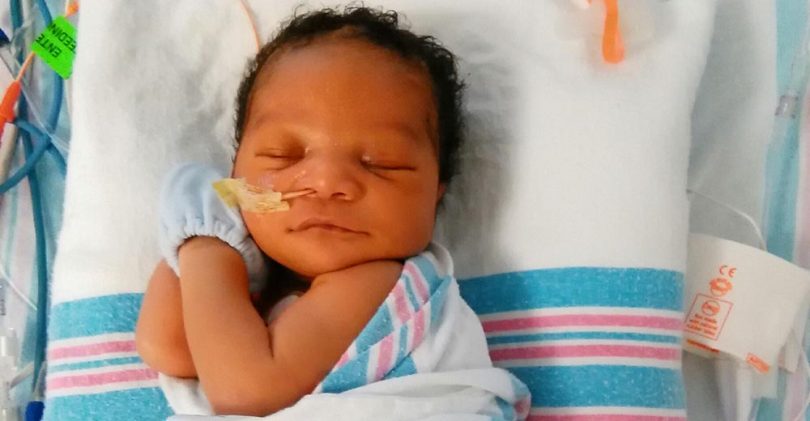It was 20 weeks, and Iris and Justin Smokes couldn’t wait to finally find out the sex of their baby.
“It’s a boy,” the ultrasound technician told them—but then the radiologist stepped in. “We have some other news. It doesn’t look like your son’s heart is developing correctly.”
It was the last thing Iris expected to hear—especially after suffering an earlier miscarriage. “Once I’d hit 15 weeks, I thought I was in the clear,” said the first-time mom-to-be, who also parents two stepchildren with her husband. “A heart defect was something we never even thought was possible because no one in our family has heart trouble.”
Their OB/GYN sent the Barnwell, S.C.-based parents to Augusta and to maternal-fetal medicine specialist Dr. Debra Ware at Augusta University Health. Ware also connected the parents with pediatric cardiologist Dr. Henry Wiles and pediatric heart surgeon Dr. Anastasios Polimenakos.
Office visits became the new normal as the parents-to-be met with their high-risk pregnancy team monthly, then every two weeks and later every week as Iris’ due date came closer. Throughout that time, nearly every visit would include an ultrasound as specialists and subspecialists began to more clearly see what was going on with their baby’s heart and define a treatment plan.
“We cried, and we prayed a lot. We worried a lot,” said Justin. “Every time we went, we thought, ‘This time, they’re going to tell us everything is better.’ Up until the first procedure, I was like, ‘They are not going to have to cut my son, he’s going to be fine.’”
The reverse would turn out to be the case. Prenatal ultrasound would soon reveal that their son, who would be named Avery, had not just one, but five cardiac defects that would require at least three procedures, with the first soon after birth.
Avery was diagnosed with dextrocardia, a genetic condition where his heart points toward the right side of his body, rather than the left. He had hypoplastic left heart syndrome, where the left side of the heart doesn’t form correctly, affecting blood flow, along with a ventricle septal defect, or a hole in the wall separating the two lower chambers of the heart. A rare condition, double outlet right ventricle, caused both his pulmonary artery and aorta to connect only to the right side of the heart. Meanwhile, those two arteries of the heart were transposed, due to a condition known as levo-transposition of the great arteries.
The Smokes would also later learn that the valves of Avery’s heart, responsible for controlling blood moving in and out of the heart, were leaking.
Despite this incredible list of conditions, the pregnancy was very nearly full-term. Iris was to be induced at the end of June, but the contractions began at 10 p.m. on June 21, when she was 38 weeks. Justin, who was at work, raced home in 15 minutes during what normally was a 30-minute drive. The typical hour-long drive to Augusta took him only about 30 minutes, with Iris updating the hospital along the way. “I was speeding, I’m not going to lie,” he said. “The reason being, with us being high-risk, I didn’t want to take any chances. I made sure we got there safe, but I wanted us to get there so that we could do what we had to do.”
It was a good thing he did. Iris’ labor was fast, especially for a first pregnancy. Avery was born at 6:58 a.m., weighing 6 pounds, 8 ounces. “He came in wide open,” said the proud father, “like, ‘Hello, I’m here.’”
The NICU team was too. As soon as the parents had their first kisses and snuggles, the team moved the baby immediately down to the 5th floor neonatal intensive care unit, with Justin following.
There were 13 more days of testing to confirm the prenatal diagnosis. “I liked that they didn’t rush to have surgery,” said Justin, “There was a lot of thought and a lot of watching and observing to make sure that this was exactly the route they should take and this is what he needs to survive. It made me feel a lot more comfortable.”
Avery would require what’s known as staged reconstruction, and at the end, his reconstructed heart would receive deoxygenated blood directly from the lungs instead of the veins, then pump the oxygenated blood back into the body.
Avery’s first procedure was a shunt to help improve his heart’s blood flow, the first step in the series of procedures he would require before his second birthday. Meanwhile, the two parents did as much as possible to care for their son themselves, learning from the NICU nurses, so that they would be ready as soon as they could go home as a family. As an example, Avery wasn’t eating enough so an NG tube was placed to deliver nutrition directly to his little tummy. The parents had to learn what to do if Avery pulled it out, including how to reinsert it; how to feed their son; and how often to replace it.
That first procedure already made a huge difference, and Avery went home on July 10. “He was a lot better afterwards, so that made us a little more at ease. The second one, it was almost like we were pros,” said Justin.
Avery would undergo his second procedure just three months later. The bi-directional Glenn procedure rerouted his superior vena cava into the right pulmonary artery to deliver deoxygenated blood from the upper body to the lungs.
Avery’s final procedure, a Fontan—which connects the inferior vena cava to the pulmonary artery so that deoxygenated blood from the lower body goes directly to the lungs—will be in 2019. But meanwhile, the Smokes are enjoying all the snuggles and smiles that come with having a four-month-old. “He’s doing great,” said Iris. “He’s not on home monitoring anymore, and his NG tube came out for the last time in early November.”
Avery is still seeing a speech therapist to help him improve his swallowing reflex, but “he’s very active,” said Iris. And the sleep? A typical new-parent answer: “It could be better,” said Justin with a laugh.
The journey is still ongoing, but the Smokes couldn’t be more grateful to have the team at the Children’s Hospital of Georgia by their side. “It’s very nerve-wracking from the start, but the staff and doctors are there for you, they’re there to coach you along the way through any problems that arise. It can be overwhelming, but you just try to learn, stay focused and move forward—and reach out to the resources that you have available,” said Justin.
“And get to know the nurses and the doctors,” added Iris. “You’re a team, and that way you’ll be on the same page. Anytime we had to leave the NICU, we always knew Avery was in good hands.”
Learn more
Click here to learn more about our Pediatric Heart Program.
[chog20]

